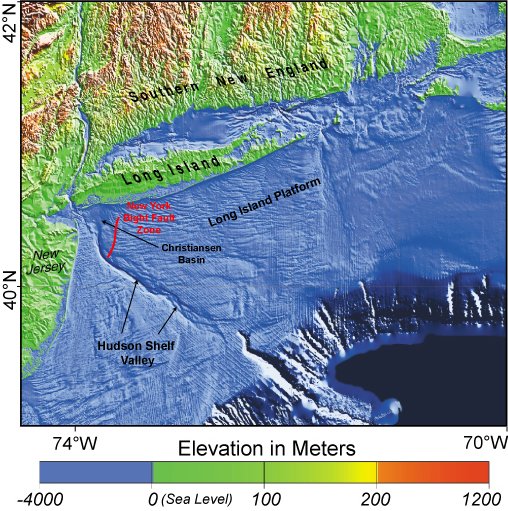Sea Birds
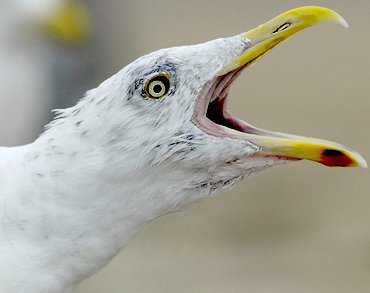
Most sea birds are strictly protected by law, and may not be approached or harassed.
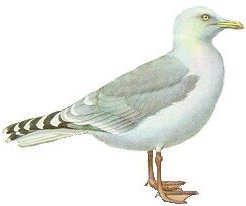
Sea Gulls are found from the oceans to the Great Plains to any parking lot.
Herring Gulls Larus argentatus (right) are large, raucous, and sometimes aggressive. They grow to 20", with a wingspan of up to 55". These birds quickly learn to accept handouts and will attack small children on the beach to steal food from them. Discourage this behavior by never feeding them. Immature specimens are as large as adults, but dirty brown.
Gulls are typically scavengers, feeding upon whatever carrion and flotsam they can find. They are also not above stealing food from other birds. Jaegers are sea birds that specialize in stealing food from gulls!
More: Sea Gulls ...
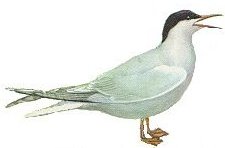
Terns are smaller and more graceful in flight than gulls. The Common Tern Sterna hirundo (right) grows to 14", wingspan 31". Their forked tails make it easy to differentiate terns from Laughing Gulls, which also have black heads.
Terns are found in the same habitats as gulls, that is to say, just about anywhere near water. Their call is a common sound along waterfronts everywhere.
More: Common Tern ...

What do you get when you cross a pigeon with a duck?
Phalacrocorax auritus
This large ( 27", wingspan 50" ) seabird is more likely to be seen around backwaters than in the open ocean. Cormorants seem rather poorly adapted to their lifestyle - they barely float, and their feathers are not waterproof like other waterfowl. As a result, they can often be seen standing on rocks and pilings or in trees in just this pose, sunning themselves to warm up and dry out after diving for fish. Despite this apparent disadvantage, they are quite successful and even manage to over-winter in the area. Cormorants are amazing swimmers and divers, able to catch fish underwater in their own environment.
More: Double-Crested Cormorant ...
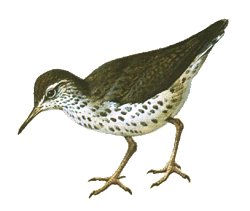
The Spotted Sandpiper Actitis macularia is the most common member of a large family of long-legged shorebirds.
They are commonly seen teetering about on beaches and salt marshes, although they may also be found in disused parking lots and other places. The breast is spotted only during the breeding season; in winter it is plain white.
Plovers are similar.
More: Sandpipers & Plovers ...

Ospreys, or "Fish Eagles", Pandion haliaetus, are fairly common along shorelines, marshes, and larger inland waterways. They dive for fish, catching them with their talons - which is quite a sight to see. At the last moment in its headlong plunge, the bird pivots to strike the water feet-first.
At 22", wingspan 54", Ospreys are smaller than eagles, but larger than hawks, and form their own family. Once threatened by DDT, which thins the shells of their eggs and makes them susceptible to breakage, Ospreys have made a great comeback and may be seen around almost any salt marsh. They nest in trees, or on special platforms that are erected for them. Several nesting pairs of Bald Eagles also live in the region.
More: Osprey ...
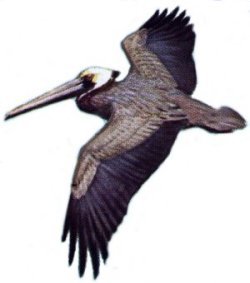
These are birds that are occasional to regular visitors to our region but do not live here year-round. Pelicans are summer visitors, Gannets are winter visitors. Others may appear any time, usually after being blown inshore by a storm. Because they can be carried thousands of miles off-course in storms, many other types of sea birds, from Europe, Africa, South America, the Arctic, and even Asia may make guest appearances as well.
Brown Pelicans Pelecanus occidentalis are southern birds that are occasionally found as far north as Cape May, rarely up to Nova Scotia. However, with the warmer temperatures of late, they seem to be expanding their normal range northward.
More: Sea Birds - Visitors ...

It is not at all uncommon for small songbirds to be blown out to sea in a strong west wind ( or a north wind, for Long Island. ) Unable to make their way back to land, these tiny fliers eventually tire and drop into the water, or get picked off by seagulls. In desperation, they will alight on anything solid to rest. An anchored dive boat makes an easy target and may collect several hitchhikers over the course of a day. This little guy was so exhausted that he even perched on a finger for photographs. Generally, though, you should just leave them alone and not frighten them further, and they will fly away on their own once the boat gets back to land.
More: Sea Birds - Stragglers ...
"Higher animals" is a catch-all term for vertebrates other than fish. This is rather self-congratulatory, since the so-called "lower animals" - fishes and invertebrates - are actually the dominant species on the planet, both in numbers and diversity! The four classes of higher animals are:
- Amphibians - class Amphibia
- Reptiles - class Reptilia
- Birds - class Aves
- Mammals - class Mammalia
Of these, amphibians are absent from marine environments ( with one or two exceptions. )
- Sea Turtles ...
- Sea Birds ...
- Sea Mammals ...
More: Higher Animals ...
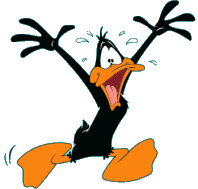
Here is an assortment of birds that might be observed in and around the water. Many of these are just as likely to be found around saltwater, just as many seabirds live happily around freshwater, and even no water.
More: Birds ...

